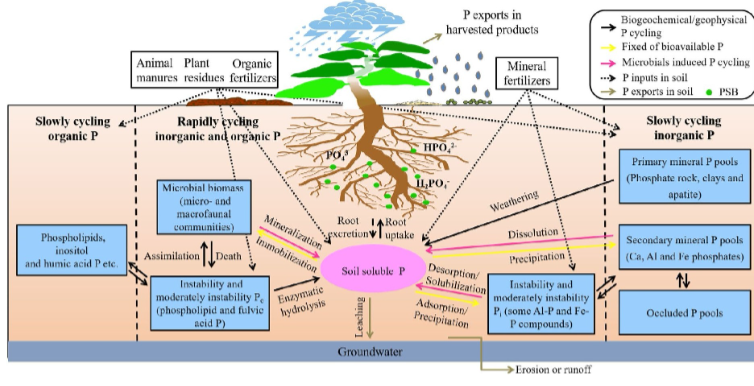Research highlights the functions of bacteria that dissolve phosphate and make phosphorus, which can improve crop yields, available in soil
05 Apr 2024

Bioavailable phosphorus (P) is critical for improving crop yields to meet the raising food demand driven by an increasing human population. Phosphate-solubilizing bacteria (PSB), as a major P activator, have gained widespread acceptance as environmentally friendly and readily available P agents to improve the acquisition of legacy P stocks in soils. This article reviews the form and transformation of soil P, and the diversity and molecular mechanisms of phosphate solubilization by PSB. Moreover, utilization of omics tools to explore microbial mediated soil P cycle and the effect of PSB inoculants on agricultural practices are summarized. We suggest that the whole native soil microbiome centered on PSB should be considered as a functional unit to promote P availability and contribute to low-input farming systems and cleaner environments.
The precise mechanism of mineral phosphate solubilization remains poorly understood, although some genes of PSB involved in mineral phosphate solubilization were cloned and characterized. Moreover, other promising novel genes and concrete functional networks have been shown to regulate the production of organic acids in the process of dissolving refractory inorganic phosphate by PSB. Therefore, it is necessary to continuously infuse new ideas
and technologies to explore key genes engaged in mobilizing mineral phosphate and reduce the susceptibility of PSB to changing soil environments based on established strategies. Increased attention should be paid to the application of multi-omics technologies centered on host genomes, combined with more commonly used microbe-focused techniques, to explore the spatiotemporal variation characteristics of biologically available P, dynamics of nutrient turnover and the genetic potential of soil microbe-mediated P cycling. It is vital to determine how PSB, as a component of the whole soil community, remobilize P to meet plant P requirements. Among these techniques, single-cell Raman spectroscopy and P tracers can be considered to discern and locate external P and internal remobilized P by PSB. Additionally, the multiple interactions of PSB with other plant growth-promoting rhizobacteria should be brought to the forefront to harness the coupling effects in the microbe-plant ecosystem.
Authors: Hui-Ping Li, Qing-Qing Han, Qiong-Mei Lui and Ya-Nan Gan (all from Key Laboratory of Grassland Livestock Industry Innovation, Ministry of Agriculture and Rural Affairs, Center for Grassland Microbiome, State Key Laboratory of Herbage Improvement and Grassland Agro-ecosystems, College of Pastoral Agriculture Science and Technology, Lanzhou University), Christopher Rencing (Institute of Environmental Microbiology, College of Resource and Environment, Fujian Agriculture and Forestry University), Christopher Rencing (Institute of Environmental Microbiology, College of Resource and Environment, Fujian Agriculture and Forestry University), Windell Rivera (Institute of Biology, College of Science, University of the Philippines Diliman), Qi Zhao and Jin-Lin Zhang (both from the Key Laboratory of Grassland Livestock Industry Innovation, Ministry of Agriculture and Rural Affairs, Center for Grassland Microbiome, State Key Laboratory of Herbage Improvement and Grassland Agro-ecosystems, College of Pastoral Agriculture Science and Technology)
Read the full paper: https://www.sciencedirect.com/science/article/pii/S0944501323000770#:~:text=Phosphate%2Dsolubilizing%20bacteria%20(PSB),the%20genetic%20potential%20of%20PSB.
